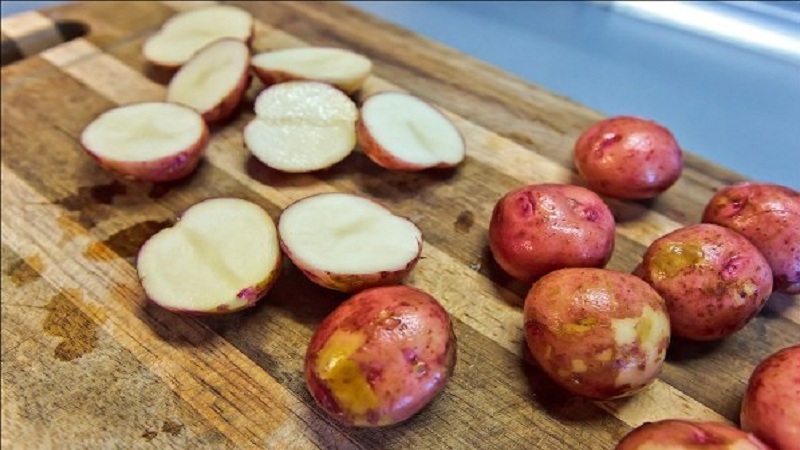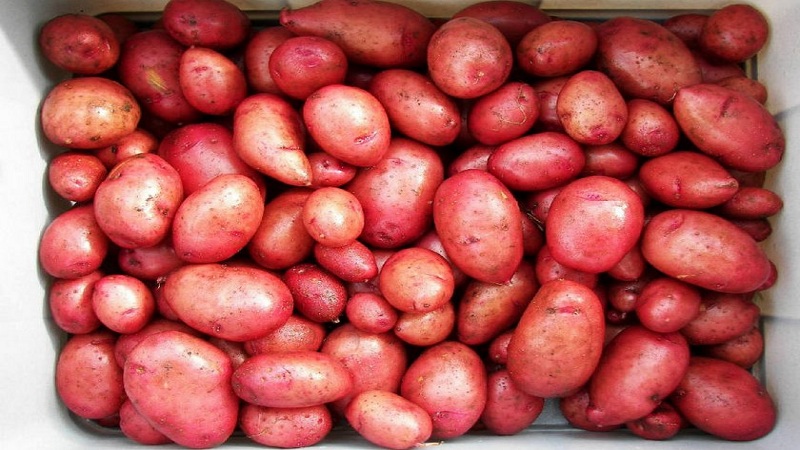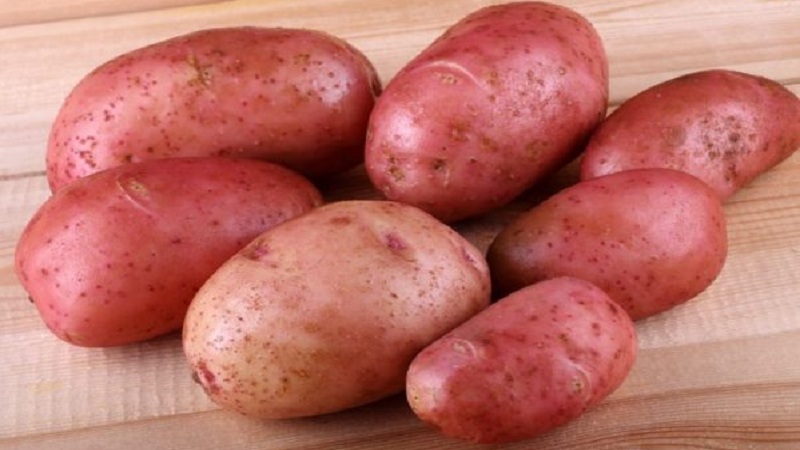Unpretentious variety of potatoes "Crimean Rose" for growing in hot climates
Crimean rose is an early ripe amateur variety with different-sized tubers of a pleasant pink color. The low starch content allows you to prepare a variety of dishes from the product by frying, stewing, baking and cooking... The firm flesh retains its structure and does not fall apart.
A rich harvest is obtained only in a warm climate with a long summer. The variety, like a real southerner, withstands drought and heat without losing its original properties.
The content of the article
Origin and description of the variety
The Crimean rose potatoes were created by amateur gardeners especially for growing on the Crimean peninsula. To the State Register of Breeding Achievements of the Russian Federation grade not included, since no special studies have been carried out. The culture is grown for their own use in personal plots. Potatoes are not suitable for cultivation for sale because of the different sizes of fruits and low transportability.
An amateur variety withstands drought and heat. In the southern regions, it is possible to harvest two crops per season.
On the territory of Russia, potatoes are grown in any area with a hot climate on light sandy soils. In regions with short and cool summers, the yield decreases, and the tubers lose their rich taste and attractive appearance.

Distinctive features of potatoes are collected in the table.
| Indicators | Characteristic |
| Ripening period | 60-65 days |
| Bush | Medium height, erect, neat |
| The number of tubers in the bush | 10-15 |
| Weight | 75-120 g |
| The form | Rounded |
| Coloration | The skin is pink, the flesh is cream or white with pink streaks |
| Leaves | Medium, green, veined and wavy edges |
| Corolla color | White |
| Starch content | 13,5-16,7% |
| Taste | Excellent (5 on a five-point scale) |
| Cooking class / group | B / C (weakly and strongly friable) |
| Yield | 140-200 c / ha |
| Marketability | 90 % |
| Keeping quality | 94-98% |
| Appointment | Dining room |
| Sustainability | To potato crayfish, black leg, common scab. Medium resistant to late blight of tops and tubers. |
| Transportability | Low |
Reference. The most expensive potato in the world is called La Bonnotte and is grown on the island of Noirmoutier off the Atlantic coast of France. One kilogram costs about 500 euros, and the tubers have a surprisingly delicate taste. The crop is grown by hand and fertilized with seaweed.
How to grow a crop
Light sandy soil is best suited for growing Crimean roses. Despite the fact that the plant grows well in dry conditions, regular watering significantly increases productivity. Planting material degenerates slowly, so the seeds are harvested from year to year without fear for the quality of the future harvest.
The culture needs organic and mineral fertilizing, loosening, weeding and preventive treatments against fungi and insects.
Timing, scheme and landing rules
In Crimea and other warm regions, potatoes are planted in the second decade of March in warm soil. Re-planting is carried out immediately after the first digging.
Tubers are sorted out before planting in the holes, small, damaged, with signs of decay are rejected. Medium-sized specimens are suitable for planting. They are picked in the fall during the harvest and stored in separate boxes.
20 days before planting, the tubers are brought out into the light, etched in a pink solution of potassium permanganate or a 5% solution of copper sulfate.Then it is soaked in growth stimulants ("Zircon", "Epin") and immersed in slightly damp sawdust. After 3-4 days, sprouts will appear at an air temperature of at least + 14 ° C.
The selected area is cleaned of plant residues, the soil is loosened and fertilized with humus, wood ash. Of the mineral dressings, it is optimal to use nitrophoska (30 g), potassium sulfate (20 g), ammonium nitrate (20 g), mixed with 5 kg of humus per 1 sq. m.
In practice, the second option is also used - 40 g of superphosphate, 450 g of dolomite flour, 20 g of ammonium nitrate, 20 g of potassium sulfate 10 kg of humus per 1 sq. m.
Reference. Potatoes absorb only 50% of nutrients during root feeding during the growing season. Therefore, farmers recommend enriching the soil just before planting tubers, and then foliar spraying with liquid mineral compositions.
Long grooves with a depth of 15 cm are formed on the plot and tubers are sealed together with sawdust, keeping a distance of 35 cm. Sprinkle with a layer of earth on top and level. Row spacing - 50 cm.
Care

Rules for caring for the Crimean rose:
- The variety is drought-resistant, does not need frequent watering. It is enough to water the bushes three times: upon reaching 15-20 cm in height, during the period of bud formation and after flowering. In the future, the need for moisture is determined by the appearance of the tops - if it is sluggish, then it's time to water the beds. For 1 sq. m - 50 liters of water. Potatoes are watered early in the morning.
- Hilling is carried out once, after the bushes are formed and get stronger. Further hilling under the conditions of the Crimean climate leads to the death of the plant.
- Loosening and weeding is carried out five days after planting, then as needed.
Fertilizers are applied according to the scheme:
- during the growth of the tops - 10 g of nitrophoska or two handfuls of humus for each bush;
- during the budding period - two handfuls of ash and earth per bush or 30 g of potassium sulfate per 10 liters of water;
- after flowering - 30 g of superphosphate, 200 ml of mullein per 10 liters of water, consumption per bush - 0.5 liters.
The nuances of growing and possible difficulties
To obtain a second crop of potatoes, a summer planting is performed... The formation and growth of tubers occurs in the fall. This creates favorable conditions for obtaining healthy, non-degenerate planting material suitable for use in the next season.
For summer planting, take tubers of the spring and summer harvest of the previous year. For 15-20 days, the seeds are laid out for germination on nets in the shade. Before this, long shoots are broken off, and tubers with threadlike seedlings are allowed to go for food needs.
Reference. Potatoes cut into pieces are not suitable for summer planting, since under conditions of elevated soil temperatures, and especially with a lack of moisture, seedlings will turn out to be rare and less productive.
Properly prepared potatoes, subject to sufficient moisture, quickly develop a strong rhizome and green mass. The potato planting period is from June 20 to July 10, in moist soil fed with organic matter and minerals. Planting depth - 10-12 cm, according to the scheme - 70x25 cm.
Diseases and pests
The variety is immune to potato cancer, black leg, common scab, but is susceptible to late blight of tops and tubers.
Signs of infection:
- dark spots on tubers and foliage;
- whitish pubescent bloom on the back of the leaves;
- curling and wilting of green mass.
For the purpose of prevention, two weeks after planting, the plants are treated with Bordeaux liquid or sprinkled with wood ash.
Treatment:
- before budding - "Oxyhom", "HOM", "Ridomil Gold MC" (two treatments with an interval of 10 days);
- after budding - "Bravo" (three times with an interval of 10 days);
- before harvesting tubers - once treated with "Alufit".
Agrotechnical techniques for the prevention of infection:
- compliance with crop rotation;
- planting tubers at a distance of at least 30 cm;
- selection of a site with good ventilation;
- disinfection of planting material with potassium permanganate, copper sulfate, "Fitosporin" before planting;
- digging potatoes in dry, sunny weather;
- top dressing with potassium-phosphorus fertilizers;
- control of nitrogen in the soil.
Potato tops are often affected by aphids and spider mites. For pest control use:
- insecticides - "Aktara", "Confidor", "Aktellik", "Danadim";
- infusion of onion peels (200 g of raw materials, 50 g of soap shavings per 5 liters of water);
- tobacco shag (400 g shag, 25 ml of liquid soap per 10 liters);
- ammonia (60 ml of ammonia, 50 g of soap shavings per 10 liters).
Bindweed cicadas, the main carriers of fungal diseases, also feed on the ground part of the potato. To destroy the pest, birds are attracted to the site (scattering food), the plants are sprayed with the preparations Prestige, Tabu, Akarin, Calypso, Decis.
To fight the Colorado potato beetle helps:
- spraying with insecticides "Colorado potato beetle NO!", "Aktara", "Killer", "Fitoverm", "Corado";
- manual collection in a jar of strong saline solution;
- dusting with birch ash (10 kg per 100 sq. m);
- mulching the beds with fresh coniferous or birch sawdust;
- irrigation of bushes with walnut infusion (300 g of dry leaves and shells per 10 liters of hot water, leave for 6-7 days);
- spraying with sunflower infusion (500 g of flowers per 10 liters of water, leave for three days).
Collection, storage and use of the crop

The first digging of Crimean rose potatoes is carried out 40 days after full shoots. Tubers acquire technical maturity in 60-80 days. They are sorted out and dried under a canopy, protected from direct sunlight, otherwise they will turn green.
Reference. The green color of the tubers is a sign of the presence of corned beef, a compound toxic to humans.
The harvest is stored in a cool place in boxes. Tubers do not lose their presentation and do not germinate for 3-4 months at a temperature of + 4-6 ° C and an air humidity of 80-90%.
In the warm climate of Crimea and other southern regions, young potatoes can be dug until late autumn.
The product has an attractive appearance, excellent taste and pronounced aroma. Tubers grow small to medium in size. The skin is easy to peel, the pulp does not boil and retains its structure. For lovers of small young potatoes, the Crimean rose is an ideal variety.
Advantages and disadvantages
The Crimean rose has many advantages:
- excellent taste;
- beautiful skin color;
- drought resistance;
- the possibility of cultivation in regions with hot, arid climates;
- disease resistance;
- early maturity;
- the ability to harvest twice a year;
- seeds do not degenerate;
- tubers are stored without losing their presentation.
There are much fewer disadvantages:
- variegated tubers;
- the variety is not suitable for cultivation in regions with cold climates;
- low transportability.
Reviews
Reviews of the Crimean rose variety are positive. The culture fell in love with many for its excellent taste, attractive appearance and unpretentious care.
Anna, Gaspra: «The Crimean peninsula is famous not only for wine and purple onions, but also for the delicious potatoes called Crimean rose. We grow it from year to year for ourselves, and we always get an excellent result. We harvest twice. Potatoes can be cooked in different ways - fried, boiled, stewed, baked, and at the same time it does not fall apart. "
Ivan, Astrakhan: “I got acquainted with the amateur variety Crimean rose quite recently. A sister from Crimea shared the seeds. Since our climate is suitable for growing these potatoes, I planted several bushes in my country house. Taste - 5 points, fruits of different sizes, but it doesn't matter, I plant potatoes for myself. The culture in the care is unpretentious, I water it once every 2 weeks, I apply fertilizer before planting. "
Pavel, Anapa: “My wife and I have a small family business. We grow vegetables for sale, including potatoes.The Crimean rose variety grows well in our country, does not need special care, and it tolerates drought. Tubers grow small to medium, with pink skin and creamy flesh, very tasty and aromatic. The structure is preserved during heat treatment. "
Read also:
How to get rid of warts with potatoes.
Does potatoes cause gas and why does the stomach swell from it?
Conclusion
Despite the fact that the Crimean rose variety is not included in the state register of the Russian Federation, this does not prevent gardeners from growing it on their plots. The culture has many advantages: the seed material does not degenerate, allowing you to get a rich harvest from year to year, the skin of the tubers is painted in an attractive pink color, and the pulp is creamy with pinkish streaks with excellent taste.
The culture has a strong immunity to cancer, scab, black leg, but is susceptible to late blight. Preventive treatment of seeds and bushes with potassium permanganate and copper-containing preparations helps to cope with infection. The fight against aphids, spider mites, Colorado potato beetles and cicadas is carried out with the help of insecticides, herbal infusions and dusting with ash.